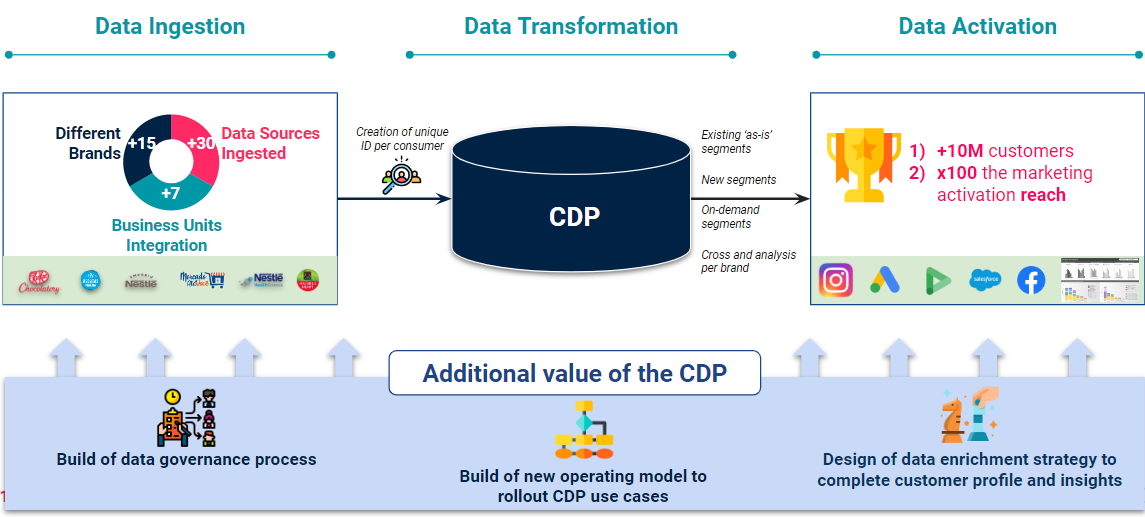The demise of third-party cookies and evolving privacy regulations are impacting the way companies can gather and use consumer data. The digital media environment is becoming more technical, with crucial customer information siloed in walled gardens, making granular targeting and measurement difficult to achieve. Moreover, today’s customers understand the value of their personal information and are choosy about what they consent to share.
Yet, with the expansion of digital channels, the number of customer touchpoints has multiplied, vastly increasing the number of data points marketers can collect and consume – and requiring a multiplication of tools (Meta, Google, Amazon…). Clearly, it’s time for a new digital marketing and measurement approach.
But if marketers can no longer rely on third-party cookies for cross-site retargeting, audience buying from external marketing platforms, and digital marketing attribution, how can they keep their audiences happy? Because despite these issues, customers want value-added experiences that are more personalized than ever, and it’s necessary to deliver them – or lose customer loyalty.
Collect a maximum of first- and second-party data
To better understand customer behavior, preferences, and the ways they engage with messages across digital channels, follow Artefact’s three-step plan:
- Gather as much first-party data as possible. The most advanced approach to collecting customer data is through developing product recommendation models, user scoring, propensity score models or CLV prediction models.
- Explore ways to leverage second-party data from large local publishers or marketplaces and combine it with first-party business-specific data.
- Build partnerships with strong media and tech partners such as Artefact’s preferred media partners Google, Meta, and Amazon, as well as LiveRamp or InfoSum.
Remember: in exchange for sharing their personal information, today’s consumers expect to receive something of value from the brand. In an article about a customer experience sentiment study on IT news-sharing website Spiceworks, an amazing 91% of consumers responded that they were likely to purchase from brands that heard their needs, and 76% of consumers said they would share their data in order to receive more personalization.
When offering incentives, ensure they have real benefit for customers. Examples of strong data value exchanges include:
- Retailers that offer customers a preview of new product lines;
- Automobile manufacturers that let prospective buyers vote on potential new features;
- Travel businesses that provide free upgrades to long-term high-value customers.
But once all this precious data has been amassed, how can it be used to benefit businesses?
Use a CDP to draw valuable insights from data
Walled garden platforms dictate audience buying, segmentation, attribution, and campaign analysis and optimization, leaving marketers with little control, ownership, transparency or efficacy.
A CDP breaks down these silos by offering marketers a unified view of their customers across different marketing platforms and channels, while assisting them with personalized marketing and targeted advertising.
The six major benefits of a CDP are:
- Improved data quality: to ensure compliance with privacy regulations and use first-party data to build better consumer experiences.
- Real-time access to first-party data: to enable use of data in real time on cross-channel marketing campaigns for moment marketing.
- Increased agility and flexibility: the proximity of data to modeling and analytics can be increased in a CDP to free up resources from analytics and development teams (absolutely marketeer-proof).
- Elimination of redundant tech: A/B testing, data visualization, and connecting in-house developed attribution models can all be run in a CDP.
- Smarter customer engagement: use first-party data assets to create new products.
- Reduced ad waste: target the right customers or prospects and suppress messaging to the wrong ones at every stage of their journey.

Illustration: How a CDP ingests, transforms, and activates data
Data ingestion: Data is integrated from different sources (e.g., brands, business units), potentially along with second-party data (publisher or marketplace) or third-party data (weather data or other business-specific data).
Data transformation: A unique ID per customer (unified customer profile) is created to rapidly identify relevant segmentation, run customer analysis, and push that data into the data activation phase.
Data activation: Marketers use the transformed data to run smarter, more data-driven campaigns by sending audience data to various marketing platforms, such as Google ads, Dv360, Meta or others. In many CDPs, data for data visualization purposes can also be sent to a Tableau or Power BI dashboard, for example.
“Make and buy” to obtain the ideal CDP for each need
To assist clients as they move to CDP capability, Artefact assesses each situation and recommends the relevant mix of make and buy. For example, an organization considering building an audience engine in an environment such as Google Cloud Platform might also benefit from the countless out-of-the-box data connectors a CDP platform such as Treasure Data, Tealium or BlueConic may already have.
From an entirely custom-made CDP to a fully-integrated out-of-the-box CDP, or anything in between, the optimal solution is to find the sweet spot between make and buy that fits each company’s requirements.
Once a solution has been selected and integrated, it’s crucial to measure the success of CDP implementation. CDP ROI can be measured in two ways:
- Through marketing-based KPIs, which are short-term, easy to measure, and show direct results:
- Increase in newsletter subscriptions.
- Incremental revenue from personalized creatives.
- Increased time on site.
- Through operational KPIs, which are long-term, harder to measure, but demonstrate more durable results:
- Reducing time spent on manual tasks.
- Less reliance on IT & Development.
- Workflow and process optimization.
Conclusion: CDPs solve key business challenges
In a recent interview, Alexandra Mangeard, Partner at Artefact, stated: “We have found that our clients face three main problems in data marketing:
- Measuring whether the impact of their data marketing strategy is aligned with their business objectives, through the building of Marketing ROI and CLTV (Customer LifeTime Value) measurement methodology and dashboards.
- Guiding their marketing team and external partners in adopting new technologies and data-driven best practices, which requires a change of habits/process and
- Adapting their paid media activation, mainly based on third-party cookie activation, to the future cookieless world.”
Artefact has strong expertise in CDP topics and first-party data strategy across multiple industries, as well as durable partnerships with trusted partners such as Google, Treasure Data, BlueConic, Tealium and Twilio Segment.
To learn more about CDP strategies tailored to meet individual business needs, get in touch with Artefact.

 BLOG
BLOG






